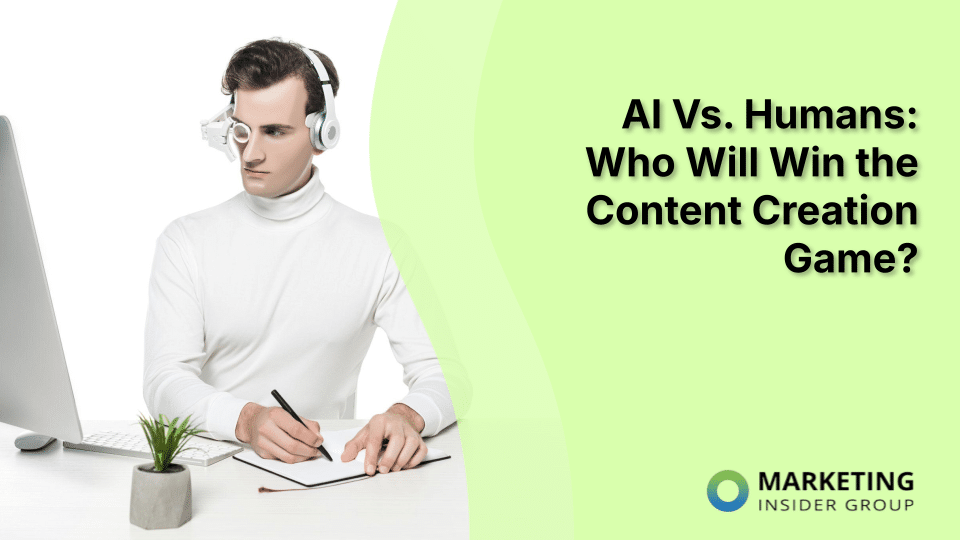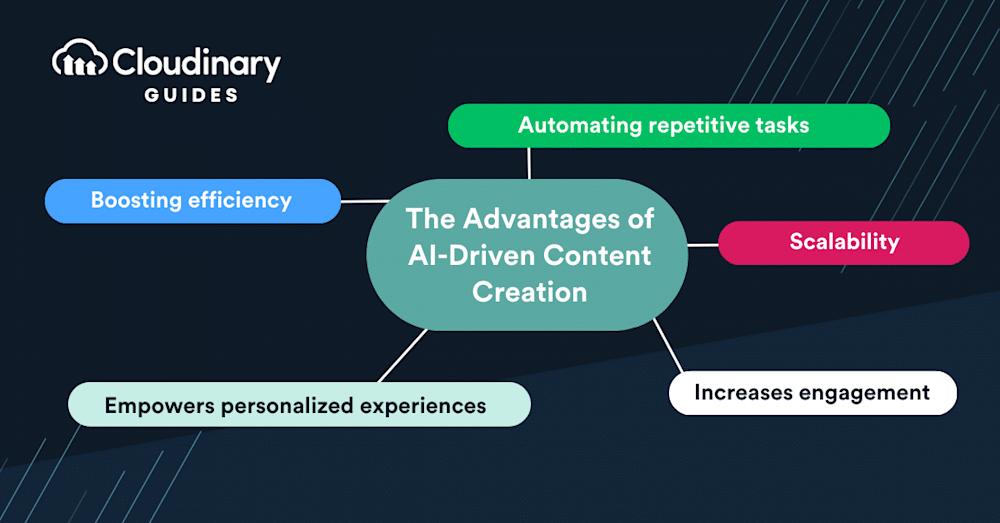
As you might know, AI is revolutionizing how brands generate articles, videos, and even art. Tools like ChatGPT and Jasper are transforming how businesses produce content, offering speed and efficiency that was once unimaginable. The Marketing AI Institute reports that 98% of marketers are using these tools, so they’re incredibly widespread already.
However, as AI’s influence grows, so does the debate: Can AI truly replace human creativity, or is there something irreplaceable about the human touch in storytelling and design?
Who will win the content creation game, or is the future one of collaboration rather than competition? This article dives into this discussion, exploring the strengths and weaknesses of both AI and human content creators.
Quick Takeaways
- AI tools like ChatGPT and Jasper excel in quickly generating large volumes of content, making them ideal for fast-paced and data-driven tasks.
- Humans bring unparalleled creativity, emotional intelligence, and nuanced understanding to content, crafting stories and messages that deeply resonate with audiences.
- While AI can produce content efficiently, it lacks genuine creativity and may perpetuate biases or misunderstand context, requiring human oversight for quality and relevance.
- The most effective content creation strategy likely involves combining AI’s strengths in speed and data analysis with human creativity and adaptability, fostering a collaborative approach.
The Rise of AI in Content Creation
AI in content creation uses advanced algorithms and machine learning models to generate various types of content, including written articles, visual designs, and multimedia presentations.
These AI tools dig into large amounts of data, recognize patterns, and produce content that mimics human-like creativity.
For example, AI can write blog posts, create digital art, or even compose music, all within a fraction of the time it would take a human.
Two AI tools gaining popularity in the content creation space are:
- ChatGPT, developed by OpenAI, is widely used for generating text-based content like articles, social media posts, and scripts.
- Jasper is an AI tool that helps marketers and writers create persuasive, SEO-optimized content.
These tools, among others, are making AI increasingly common in the content creation industry.
The Advantages of AI
One of the most significant advantages of AI is its speed and efficiency. AI can produce content much faster than humans, so it’s an ideal solution for organizations needing to generate large volumes of material quickly.

It’s also cost-effective, as AI can perform tasks that typically require a team of writers, designers, or analysts.
AI’s ability to process large datasets allows it to generate insights and tailor content to specific audiences with remarkable precision.
This combination of speed, cost savings, and data-driven insights is why AI is a valuable tool in content creation.
The Unique Strengths of Human Content Creators
While AI is making significant strides in content creation, human creators have irreplaceable strengths like creativity and emotional intelligence.
Humans can infuse content with nuance, originality, and emotional depth, crafting stories, images, and ideas that appeal to the reader on a personal level. This creativity allows humans to generate content that informs, inspires, entertains, and moves audiences in ways that AI struggles to replicate.
Another key strength of human content creators is their understanding of context and audience. Humans can tailor content to specific cultural contexts, adapting tone, style, and messaging to suit different audiences.
This understanding allows for content that feels relevant, authentic, and engaging, something that AI, with its reliance on patterns and data, often can’t achieve.
Human adaptability and critical thinking are also important. Unlike AI, which follows predefined algorithms, humans can analyze trends, assess shifting market needs, and adjust content strategies accordingly.
This ability to think critically and shift when necessary ensures that human-generated content remains fresh, relevant, and impactful.
These unique strengths will keep human content creators relevant, even as AI use grows and the technology becomes more advanced.
The Limitations of AI in Content Creation
Despite its strengths, AI has significant limitations.
For example, AI generates content by analyzing patterns in existing data, which means it can replicate styles and formats but struggles with genuine creativity and innovation.

AI can’t think outside the box, develop original ideas, or infuse content with unique perspectives. This reliance on existing data means that AI often produces formulaic content lacking the emotional depth only human creativity can provide.
Biases in AI
Another major limitation of AI is its tendency to make contextual errors and perpetuate biases.
AI operates based on algorithms that don’t always understand the nuances of language, culture, or context. As a result, AI-generated content can sometimes misinterpret the intended meaning or miss important subtleties, leading to awkward phrasing or even offensive content.
Since AI learns from existing data, it can unintentionally reinforce biases present in that data, further complicating its use in sensitive or culturally diverse contexts.
AI’s effectiveness is also heavily dependent on human input. AI requires human oversight to ensure its content’s quality, accuracy, and relevance.
Without careful human guidance, AI-generated content can miss the mark and lack the refinement and context needed to connect with audiences. This reliance on human intervention highlights the fact that, despite its capabilities, AI is not yet capable of entirely replacing human content creators.
Collaboration Between AI and Humans
Rather than viewing AI and humans as competitors, the future could involve collaboration. AI is helpful for human creators, assisting with tasks like idea generation, content editing, and data analysis.
For instance, AI can quickly generate topic ideas or provide draft content that human creators can refine, adding creative and emotional elements that appeal to audiences.
There are already numerous examples of successful collaboration between AI and humans. Journalists use AI tools to draft initial reports, which human editors enhance with context and storytelling.
In marketing, writers sometimes use AI-generated content to optimize SEO and performance metrics, while humans craft the messaging and brand voice.
The collaboration between AI and humans will likely grow in the future. AI will continue to handle repetitive tasks and data-heavy analysis, freeing humans to focus on creative and strategic aspects. This partnership will make the content creation process more efficient for everyone.
Get the Content You Need
AI and human creators have distinct strengths and limitations. AI excels in speed, efficiency, and data-driven insights, so it’s a worthwhile tool for generating content at scale. However, it falls short in areas requiring true creativity, emotional depth, and the nuanced understanding of context only humans can provide.
A collaborative approach allows businesses to produce high-quality content that is efficient and engaging. Marketing Insider Group can deliver this content through our Content Builder Services. Reach out to learn more or book your free appointment with our team.

0 Commentaires